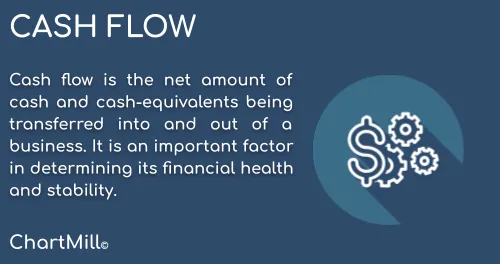Price to Free Cash Flow: What is it? How to calculate it? How to use it?
By Kristoff De Turck - reviewed by Aldwin Keppens
~ 4 minutes read - Last update: Apr 19, 2024
The Price to Free Cash Flow ratio
The Price to Free Cash Flow ratio is a valuation metric that compares a company's market price per share to its free cash flow per share. Free cash flow represents the cash generated by a company after accounting for its operating expenses, capital expenditures, and taxes.
It is a measure of a company's ability to generate cash that is available to be distributed to investors, reinvested in the business, or used for other purposes.
Highlights
-
A low P/FCF ratio suggests that a company is generating strong cash flow relative to its market price.
-
The P/FCF ratio helps investors determine whether a company's stock is overvalued or undervalued in the market.
-
The value of the ratio is highly dependent on the specific industry the company belongs to.
Calculation of Price to Free Cash Flow
To calculate the Price to Free Cash Flow ratio, you need two key pieces of information: the market price per share and the free cash flow per share. The formula for calculating the P/FCF ratio is as follows:
Price to Free Cash Flow = Market Price per Share / Free Cash Flow per Share
The market price per share is the current trading price of a company's stock, while the free cash flow per share is calculated by dividing the company's free cash flow by the total number of outstanding shares.
For example, let's assume a company has a market price per share of $50 and a free cash flow per share of $5. In this case, the Price to Free Cash Flow ratio would be:
P/FCF = $50 / $5 = 10
This implies that investors are willing to pay 10 times the company's free cash flow per share to own the stock.
What Does It Say?
The Price to Free Cash Flow ratio is widely used by investors and analysts for several reasons. It provides insights into a company's financial health, profitability, and investment potential.
A low P/FCF ratio suggests that a company is generating strong cash flow relative to its market price, indicating healthy financial performance.
The P/FCF ratio helps investors determine whether a company's stock is overvalued or undervalued in the market. By comparing the market price of a share to its free cash flow, investors can assess whether the stock is priced attractively relative to the cash generated by the business.
Keep in mind that there are no standard values that indicate whether the ratio is good or not. This is because the value of the ratio is highly dependent on the specific industry the company belongs to. So use this ratio to value comparable companies and take into account the industry average. A P/FCF that is lower than the average is a first indication that the stock is undervalued. In the opposite case (the ratio is higher than the industry average), it may be overvalued.
However, be sure to keep an eye on cash flow trends. Increasing free cash flow due to revenue growth or improving profit margins is often an indication that profits will be higher in the future. While doing so, be sure that cash flow growth is not due solely to cost reductions, as this is not structurally sustainable over the long term.
In summary, a low stock price, combined with rising free cash flow increases the likelihood of a stock price increase.
FAQs (Frequently Asked Questions)
How does the Price to Free Cash Flow ratio differ from other valuation ratios?
While other valuation ratios, such as the price-to-earnings (P/E) ratio, focus on profitability, the Price to Free Cash Flow ratio emphasizes a company's ability to generate cash. It takes into account the cash flow aspect, which is crucial in assessing a company's financial stability.
Can this ratio be manipulated?
As is the case with some other ratios, one must be wary of possible manipulation that could distort the result.
For example, the price-to-free cash flow can quite easily be positively influenced by delaying stock purchases until after the publication of the financial figures.
Is a low Price to Free Cash Flow ratio always favorable for investors?
A low Price to Free Cash Flow ratio is generally considered favorable for investors as it suggests that a company is generating strong cash flow relative to its market price. However, investors should also consider other factors such as industry trends, competitive landscape, and growth prospects before making investment decisions.
Can the Price to Free Cash Flow ratio be negative?
Yes, the Price to Free Cash Flow ratio can be negative if a company has negative free cash flow. This typically occurs when a company's cash outflows exceed its cash inflows. Negative ratios indicate that the company's free cash flow is insufficient to cover its market price.
Be careful, though, about jumping to conclusions; negative cash flow is not always a bad thing. Significant (but sometimes necessary) investments made by a company may result in negative free cash flow one year but may lead in a significant return on investment in the future.
Therefore, it is essential to track and analyze free cash flow over relatively long periods. This is the only way to assess the company's true ability to generate cash.
Is the Price to Free Cash Flow ratio suitable for all types of companies?
While the Price to Free Cash Flow ratio is useful for many companies, it may not be appropriate for certain industries or sectors. For example, capital-intensive companies or those with significant investment requirements may have lower free cash flow, resulting in higher P/FCF ratios. It's important to consider industry-specific factors when interpreting the ratio.
What’s the difference between the price/cash flow vs the price/free cash flow?
The difference between the two is quite important. Unlike the P/CF, to calculate the P/FCF ratio, investments, working capital, and dividends payable are also taken into account. After all, these are obligations that the company must meet. What remains is free cash flow that the company can use at will.
Can the Price to Free Cash Flow ratio be used in isolation to make investment decisions?
No, the Price to Free Cash Flow ratio should not be used in isolation to make investment decisions. It is essential to analyze the ratio alongside other financial metrics, qualitative factors, and industry trends to gain a comprehensive understanding of a company's investment potential.
Related Articles
What is Cash Flow?
Cash flow is the movement of money into or out of a business. It is the net amount of cash and cash-equivalents being transferred into and out of a business. Read more...
Free Cash Flow Per Share
Free cash flow per share is a financial metric that indicates the amount of cash generated by a company's operations after accounting for its capital expenditures (capex), interest expenses, and taxes.Read more...
Mastering Cash Flow Analysis: The Importance of FCF Margin
Free Cash Flow (FCF) margin is a financial metric that measures the percentage of revenue a company generates as free cash flow, relative to its total revenue. Read more...







